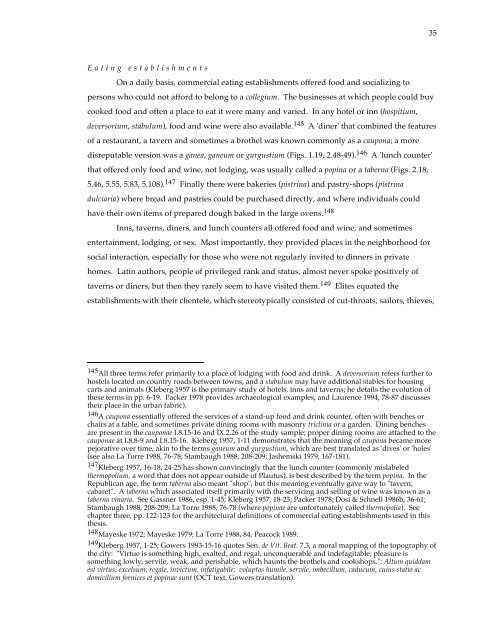KITCHENS AND DINING ROOMS AT POMPEII ... - Get a Free Blog
KITCHENS AND DINING ROOMS AT POMPEII ... - Get a Free Blog
KITCHENS AND DINING ROOMS AT POMPEII ... - Get a Free Blog
You also want an ePaper? Increase the reach of your titles
YUMPU automatically turns print PDFs into web optimized ePapers that Google loves.
Eating establishments<br />
On a daily basis, commercial eating establishments offered food and socializing to<br />
persons who could not afford to belong to a collegium. The businesses at which people could buy<br />
cooked food and often a place to eat it were many and varied. In any hotel or inn (hospitium,<br />
deversorium, stabulum), food and wine were also available. 145 A 'diner' that combined the features<br />
of a restaurant, a tavern and sometimes a brothel was known commonly as a caupona; a more<br />
disreputable version was a ganea, ganeum or gurgustium (Figs. 1.19, 2.48-49). 146 A 'lunch counter'<br />
that offered only food and wine, not lodging, was usually called a popina or a taberna (Figs. 2.18,<br />
5.46, 5.55, 5.83, 5.108). 147 Finally there were bakeries (pistrina) and pastry-shops (pistrina<br />
dulciaria) where bread and pastries could be purchased directly, and where individuals could<br />
have their own items of prepared dough baked in the large ovens. 148<br />
Inns, taverns, diners, and lunch counters all offered food and wine, and sometimes<br />
entertainment, lodging, or sex. Most importantly, they provided places in the neighborhood for<br />
social interaction, especially for those who were not regularly invited to dinners in private<br />
homes. Latin authors, people of privileged rank and status, almost never spoke positively of<br />
taverns or diners, but then they rarely seem to have visited them. 149 Elites equated the<br />
establishments with their clientele, which stereotypically consisted of cut-throats, sailors, thieves,<br />
145 All three terms refer primarily to a place of lodging with food and drink. A deversorium refers further to<br />
hostels located on country roads between towns, and a stabulum may have additional stables for housing<br />
carts and animals (Kleberg 1957 is the primary study of hotels, inns and taverns; he details the evolution of<br />
these terms in pp. 6-19. Packer 1978 provides archaeological examples, and Laurence 1994, 78-87 discusses<br />
their place in the urban fabric).<br />
146 A caupona essentially offered the services of a stand-up food and drink counter, often with benches or<br />
chairs at a table, and sometimes private dining rooms with masonry triclinia or a garden. Dining benches<br />
are present in the cauponae I.8.15-16 and IX.2.26 of the study sample; proper dining rooms are attached to the<br />
cauponae at I.8.8-9 and I.8.15-16. Kleberg 1957, 1-11 demonstrates that the meaning of caupona became more<br />
pejorative over time, akin to the terms ganeum and gurgustium, which are best translated as 'dives' or 'holes'<br />
(see also La Torre 1988, 76-78; Stambaugh 1988, 208-209; Jashemski 1979, 167-181).<br />
147 Kleberg 1957, 16-18, 24-25 has shown convincingly that the lunch counter (commonly mislabeled<br />
thermopolium, a word that does not appear outside of Plautus), is best described by the term popina. In the<br />
Republican age, the term taberna also meant "shop", but this meaning eventually gave way to "tavern,<br />
cabaret". A taberna which associated itself primarily with the servicing and selling of wine was known as a<br />
taberna vinaria. See Gassner 1986, esp. 1-45; Kleberg 1957, 18-23; Packer 1978; Dosi & Schnell 1986b, 36-61;<br />
Stambaugh 1988, 208-209; La Torre 1988, 76-78 (where popinae are unfortunately called thermopolia). See<br />
chapter three, pp. 122-123 for the architectural definitions of commercial eating establishments used in this<br />
thesis.<br />
148 Mayeske 1972; Mayeske 1979; La Torre 1988, 84, Peacock 1989.<br />
149 Kleberg 1957, 1-25; Gowers 1993-15-16 quotes Sen. de Vit. Beat. 7.3, a moral mapping of the topography of<br />
the city: "Virtue is something high, exalted, and regal, unconquerable and indefagitable; pleasure is<br />
something lowly, servile, weak, and perishable, which haunts the brothels and cookshops."; Altum quiddam<br />
est virtus, excelsum, regale, invictum, infatigabile: voluptas humile, servile, imbecillum, caducum, cuius statio ac<br />
domicilium fornices et popinae sunt (OCT text, Gowers translation).<br />
35


